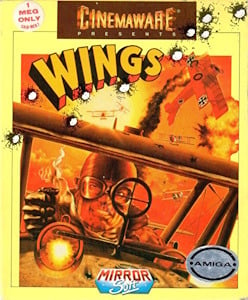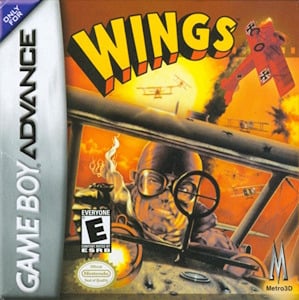Wings (1990-)
Wings was developed by Cinemaware and released in 1990 as a cinematic World War I flight combat game. Published by Cinemaware itself, the game offered a unique blend of arcade-style dogfighting, strategic mission planning, and storytelling that set it apart from traditional flight simulators of the time. Inspired by classic war films and the early days of aerial combat, Wings captured the drama and danger faced by fighter pilots during the Great War. Its focus on narrative, combined with engaging action sequences, helped create a memorable experience that appealed to both aviation enthusiasts and casual gamers.
Initially released for the Commodore Amiga, Wings was later ported to several other platforms, including MS-DOS, the TurboGrafx-16, and the Sega CD. Each version sought to retain the cinematic feel and gameplay variety, featuring a mix of dogfights, bombing missions, and reconnaissance tasks. The game’s soundtrack played a significant role in building atmosphere, with a stirring orchestral score that complemented the dramatic tone of the game. The music and sound effects helped immerse players in the perilous world of early aviation warfare, enhancing both the tension and excitement of each mission.
While Wings did not have any direct prequels, it was part of Cinemaware’s broader approach to blending interactive storytelling with arcade-style gameplay, a hallmark of the company’s titles during the late 1980s and early 1990s. The game was promoted primarily through gaming magazines and industry events, with marketing highlighting its cinematic presentation and emotional depth. This narrative-driven approach distinguished Wings from other flight games that focused more strictly on simulation or action, attracting players interested in a richer, more story-centered experience.
Upon release, Wings was met with critical acclaim, praised for its innovative mix of gameplay styles, compelling storytelling, and impressive graphics for the time. Reviewers admired how the game balanced arcade combat with strategy and narrative, creating an engaging and emotional experience. The title developed a dedicated fan base and is often cited as one of the standout games of the Amiga era. Its success led to a sequel, Wings 2: Aces High, released years later, continuing the legacy of combining aerial combat with immersive storytelling.
Images from MobyGames
Buy Wings
Click one of the Ebay or Amazon buttons below to check the latest prices and purchase Wings for that particular platform.


Related Searches
Wings is available to purchase and download from a range of vendors. Always shop....
Wings may be available to download as abandonware from one of the many sites that offer this...
There are various sites out there that can offer cheat codes for games. Search now to find all available...
There are many sites out there that have collated and documented historic reviews of this game. Search now...
We don't host or link to rom sites for this game. However, there are many sites out there that may be...
The initial release date for Wings is stated as October 1990. Other ports of the game may....
Wings is available to purchase and download from the link(s) shown further up this....
There are multiple sites around the internet that offer visual guides to this game. Search now to find the....








